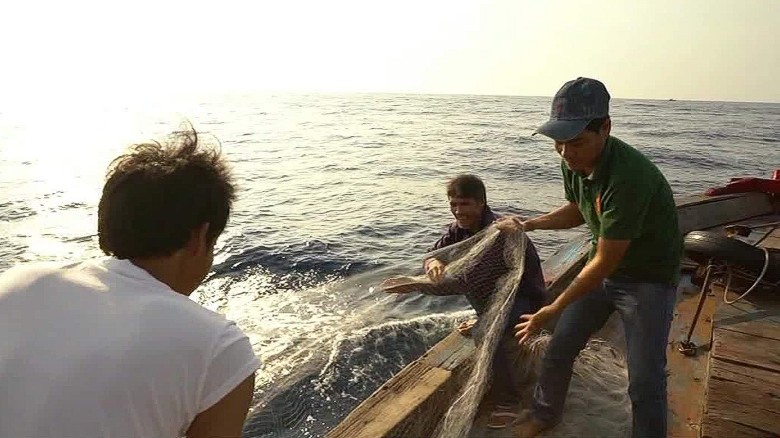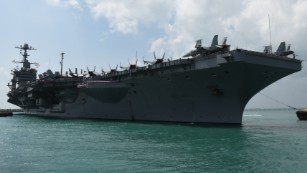South China Sea: Court rules in favor of Philippines over China
An international tribunal in The Hague ruled in favor of the Philippines in a maritime dispute Tuesday, concluding China has no legal basis to claim historic rights to the bulk of the South China Sea.
Chinese President Xi Jinping rejected the decision by the Permanent Court of Arbitration, which is likely to have lasting implications for the resource-rich hot spot, which sees $5 trillion worth of shipborne trade pass through each year.
"China will never accept any claim or action based on those awards," Xi said. China had boycotted the proceedings.
The tribunal concluded that China doesn't have the right to resources within its "nine-dash line," which extends hundreds of miles to the south and east of its island province of Hainan and covers some 90% of the disputed waters.
Viewed as a decisive win for the Philippines, the ruling could heighten friction in a region already bristling with tension, especially if it unleashes a defiant reaction from China.
The United States, which has been at odds with China over freedom of navigation in the South China Sea, urged all parties "to avoid provocative statements and actions."
Other countries could be emboldened
The ruling doesn't just affect China and the Philippines, but other countries that have competing claims with the nation over large areas of the sea.
Chinese ship 'shadows' U.S. carrier
Malaysia, Vietnam and Indonesia have also taken exception to China's growing presence in the region and could now be emboldened to take further action.
"If China's nine-dash line is invalid as to the Philippines, it is equally invalid to those States and, indeed, the rest of the international community," the lawyers who led the Philippines' legal team said in a statement.
Japan, a key U.S. ally and China's neighbor, issued a statement saying it "strongly expects that the parties' compliance with this ruling will eventually lead to the peaceful settlement of disputes in the South China Sea."
What's the U.S. role in all of this?
The United States is a major player in the region and has sent warships and military aircraft around the South China Sea, including near disputed reefs and shoals, citing international law and freedom of movement but triggering harsh warnings from China.
Washington takes no position on the territorial disputes in the South China Sea but has called for an immediate end to land reclamation.
President Barack Obama has urged a peaceful resolution to the dispute and while visiting Vietnam in May said that big nations shouldn't bully small ones.
But as China has been at pains to point out, the United States isn't among the 180 countries that have ratified the U.N. Convention on the Law of the Sea -- potentially undermining its clout on this issue.
"This decision can and should serve as a new opportunity to renew efforts to address maritime disputes peacefully," the U.S. State Department said in a statement.

High stakes surveillance over the South China Sea
The findings
The tribunal also found that none of the sea features claimed by China were capable of generating what's called an exclusive economic zone -- which gives a country maritime rights to resources such as fish and oil and gas within 200 nautical miles of that land mass.
It deemed they were rocks or low-tide elevations such as reefs, rather than islands.
Because China had no rights to the area as an exclusive economic zone, the tribunal found that some of its activities in the region were in breach of the Philippines' sovereign rights.
China had violated those rights by interfering in fishing and oil exploration, constructing artificial islands and failing to stop Chinese fisherman from fishing the zone, the ruling said.
The panel found China had caused "severe harm" to coral around the site of its artificial islands. It had also "violated its obligation to preserve and protect fragile ecosystems."
Chinese fisherman had also killed endangered sea turtles and giant clams "on a substantial scale" -- with the full knowledge of China, the tribunal said.

Fishermen caught up in South China Sea tensions
How we got here
The Philippines and China have long been at odds over Beijing's claims of sovereignty over large swaths of the South China Sea, and Manila took its fight to the court in 2013.
Tensions have ratcheted up as China has reclaimed land in massive dredging operations, turning sandbars into islands equipped with airfields, ports and lighthouses.
China had refused to participate in the case, which marks the first time an international court has ruled on the region's mess of overlapping claims.
Feelings were running high on both sides of the dispute in the run-up to Tuesday's ruling.
In the Philippines, the hashtag #CHexit was trending on Twitter -- calling for China to leave the South China Sea.
The topic was also the most widely discussed on the Chinese social network Weibo, China's equivalent of Twitter, with hundreds of thousands of users sharing a map of China with its nine-dash line and the caption "China can't be one dash less."
Showdown in the South China Sea: Timeline
The South China Sea is home to a messy maritime dispute. China, Malaysia, the Philippines, Taiwan and Vietnam all dispute sovereignty of several island chains and nearby waters.
1947
Nine-dash line
China publishes a map outlining its claims in the South China Sea. The map becomes the basis of the "nine-dash line" -- the foundation of China's current territorial claims.
January 1974
China occupies the Paracel Islands
China builds a military installation on Woody Island with an airstrip and artificial harbor. It has occupied all the Paracel Islands since 1974, when Chinese troops seized a South Vietnamese garrison. The islands are also claimed by Taiwan and Vietnam.
Deadly skirmish
Chinese and Vietnamese sailors square off over Johnson South Reef as the two countries scramble for a physical presence in the Spratlys. Vietnam says 64 of its soldiers were killed in the battle.
Declaration of conduct
China and members of ASEAN sign a "Declaration on the Conduct of Parties in the South China Sea." The accord eases tensions but falls short of a legally binding code of conduct.
May 2005 — 2006
Taiwan builds airstrip
Taiwan builds a a 1,200 meter runway at Itu Aba island, the only island it controls in the South China Sea and the largest naturally occuring island in the Spratlys.
May 2009
China makes submission to U.N.
In a submission to the United Nations, China claims sovereignty over the islands in the South China Sea and adjacent waters. To support its claim, it attaches a map of the "nine-dash line" -- its claimed territorial waters that extend hundreds of miles to the south and east of its island province of Hainan. Vietnam and Malaysia object.
New passports
The Philippines and Vietnam condemn a new Chinese passport design that contains a map of China's disputed maritime claims in the South China Sea.
January 2013
Philippines vs. China
The Philippines files a case with the Permanent Court of Arbitration in The Hague. It seeks a ruling on its right to exploit the South China Sea waters in its 200-nautical mile exclusive economic zone (EEZ) as allowed under the United Nations Convention on the Law of the Sea (UNCLOS). Beijing refuses to participate.
Tourists arrive
China says it has started allowing tourists to visit Woody Island in the Paracels as part of a cruise.
May 2, 2014 — July 15, 2014
Oil rig dispute
Chinese oil company CNPC moves an oil exploration rig near to Triton Island in the Paracels. Anti-Chinese riots erupt in Vietnam, causing damage to businesses. Vietnamese vessels approach the rig but are stopped by Chinese boats. The standoff ends when China moves the rig on July 15, a month earlier than planned.
Airstrip-capable island
Satellite images analyzed by IHS Jane's Defence Weekly suggest China is building an island at Fiery Cross Reef in the Spratlys big enough for an airstrip.
Island building
Satellite imagery shows China building a "significant presence" in the Spratlys, reclaiming land at a total of five sites and building airstrips. IHS Jane's Defence Weekly describes it as a "methodical, well-planned campaign" to create a chain of air and sea capable "fortresses."
U.S. plane warned
China's Navy warns a U.S. surveillance plane carrying a CNN crew eight times as it flies over man-made islands in the Spratlys.
June 16, 2015
China says reclamation "almost finished"
China says it has "almost completed" land reclamation in the South China Sea. According to the U.S., China has reclaimed some 3,000 acres of land since the beginning of 2014.
October 26, 2015 — January 30, 2016
U.S. tests freedom of navigation
The United States sends a warship, the USS Lassen, within 12 nautical miles of one of China's man-made islands -- Fiery Cross Reef in the Spratlys. The U.S. conducts a similar "freedom of navigation" operation near Triton Island in the Paracel Islands January 30, 2016. China objects to both, tracking and warning the vessels.
January 2016
Test flights
Chinese civilian airliners land on a freshly completed runway at Fiery Cross Reef, drawing objections from Vietnam.
LOADING
February 2016
Missiles deployed
China deploys surface-to-air missiles and fighter jets on Woody Island in the Paracels as U.S. President Obama meets with ASEAN leaders. Obama calls for a halt to construction or militarization in Asia's seas.
What happens now?
Despite being considered a strong ruling against China, the decision offers no clues to what happens next.
The tribunal said it "lacked the jurisdiction to consider the implications of a stand-off" between the Chinese and Philippines military, specifically at Second Thomas Shoal, and said any resolution of the dispute was "excluded from compulsory settlement."
The tribunal hasn't ordered China to take any particular steps to remedy the situation, dismantle construction on the islands or provide reparations to the Philippines.
And while the ruling is regarded as legally binding, there is no mechanism to enforce it.
"In terms of enforcement, much will depend on what the Philippines is now prepared to assert against China based on the award and China's responses to those assertions," said Natalie Klein, an international law professor at Macquarie Law School in Australia
News Courtesy: www.cnn.com












